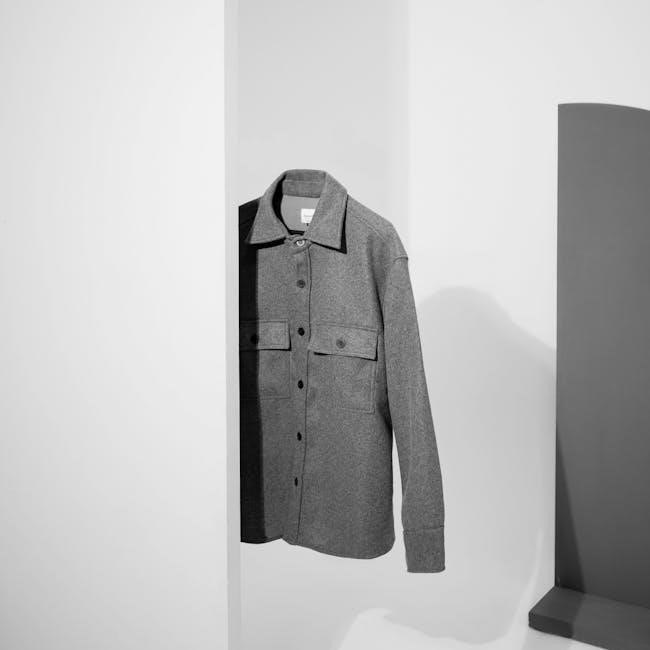
shirt collar size guide
Understanding your shirt collar size is essential for a perfect fit. This guide helps you measure accurately, choose between regular or slim fits, and ensures comfort and style.
Why Collar Size Matters for a Perfect Fit
A well-fitting collar is crucial for both comfort and style. If the collar is too tight, it can cause discomfort and restrict movement, while a collar that’s too loose may look sloppy and unprofessional. Proper collar sizing ensures the shirt sits correctly on the body, maintaining a balanced appearance. A collar that fits perfectly allows for the desired amount of space—ideally, you should be able to fit two fingers comfortably between the collar and your neck. Incorrect sizing can lead to issues like puckering or gaping, which can ruin the shirt’s tailored look. Choosing the right collar size is the foundation of a great-fitting shirt, making it essential to measure accurately and select the appropriate size for your body type.

How to Measure Your Collar Size
Measure around the base of your neck where the collar sits, keeping the tape level and not too tight; Add half an inch for comfort.
Step-by-Step Guide to Measuring Your Neck
To measure your neck for collar size, start by standing upright and relaxing your shoulders. Place a flexible tape measure around the base of your neck, where a shirt collar would naturally sit. Ensure the tape is level and not too tight or too loose. The ideal position is just above the Adam’s apple, with the tape parallel to the floor. Gently snug the tape to your skin, allowing space for two fingers to fit comfortably between the tape and your neck. Take note of the measurement in inches or centimeters, and add half an inch for a comfortable fit. This ensures accuracy and comfort when selecting your shirt size.
How to Ensure Accuracy in Measurements
To ensure accurate neck measurements for your shirt collar size, use a flexible tape measure and stand upright with relaxed shoulders. Place the tape around the base of your neck, just above the Adam’s apple, and keep it parallel to the floor. The tape should be snug but not tight, allowing space for two fingers to fit comfortably. Avoid slouching or pulling the tape too tight, as this can lead to incorrect sizing. Take the measurement in inches or centimeters and add half an inch for comfort. Double-check your measurement by comparing it to a well-fitting shirt. Consistency and proper technique are key to achieving the most accurate results.
Understanding Shirt Collar Size Charts
Shirt collar size charts provide standardized measurements to help determine the perfect fit. They typically include collar, chest, and sleeve measurements in inches or centimeters for men and women.
Standard Collar Size Ranges for Men
For men, standard collar sizes typically range from 15 to 17.5 inches, corresponding to chest measurements and sleeve lengths. Small sizes (15-15.5 inches) suit slimmer builds, while medium (15.5-16 inches) fits average necks. Large sizes (16-16.5 inches) and extra-large (16.5-17 inches) accommodate broader frames. XXXL sizes (17-17.5 inches) are for the largest neck circumferences. These measurements ensure comfort and style, allowing for two fingers of space between the collar and neck. Charts often include chest and sleeve measurements to help match body types. Variations may exist between brands, so comparing measurements is key for the best fit.
Standard Collar Size Ranges for Women
Women’s shirt collar sizes typically range from 12 to 16 inches, designed to fit various neck sizes comfortably. Small sizes (12-13 inches) are ideal for petite frames, while medium (13-14 inches) suits average necks. Larger sizes (14-15 inches) and extra-large (15-16 inches) accommodate broader or taller builds. These measurements ensure a snug yet comfortable fit, with enough room for one finger between the collar and skin. Charts often align collar sizes with chest measurements to ensure a balanced fit. Brands may vary slightly, so consulting specific size guides is recommended for accuracy. Proper fit enhances both comfort and style.
International Size Conversion Guide
Collar sizes vary globally, requiring conversion for international purchases. US sizes often range from 14 to 18 inches, while European sizes typically use centimeters (36-46 cm). UK sizes align closely with US measurements but may differ slightly. Asian sizes tend to be smaller, starting around 34 cm. Converting inches to centimeters involves multiplying by 2.54. For example, a 15-inch collar is approximately 38.1 cm. Using an international size chart ensures accurate fit when shopping across brands or regions. Always refer to the specific brand’s conversion guide, as standards can vary slightly. This guide helps bridge size discrepancies, making global shopping seamless and stress-free for all customers.

Different Types of Shirt Fits
Shirts come in various fits like regular, slim, and tailored. Each fit offers a unique silhouette, catering to different body types and personal style preferences comfortably.
Regular Fit vs. Slim Fit Collar Sizes
Regular fit shirts offer a classic, comfortable silhouette with a slightly looser cut, while slim fit shirts provide a more tailored, modern look with a narrower collar.

How to Choose the Right Collar Size for Your Body Type
Choosing the right collar size involves considering your body type and personal comfort. For slim builds, a slim-fit collar provides a sleek look, while broader shoulders may benefit from a regular fit. Measure your neck at the base where the collar sits, ensuring two fingers fit comfortably. If you have a larger chest or waist, opt for a slightly larger collar size to maintain balance. For athletic builds, ensure the collar isn’t too tight to allow ease of movement. Pair your collar size with sleeve length proportionate to your height for a polished appearance. This ensures a flattering fit tailored to your physique.

Comparing Collar Sizes Across Brands
Collar sizes can vary significantly between brands due to differences in measurement standards and fit styles. Some brands use traditional inch measurements, while others adapt metric systems or custom fits. For instance, one brand’s size 15 might equate to another’s 15.5. It’s crucial to consult each brand’s specific size chart, as their definitions of small, medium, or large may differ. Additionally, factors like regular fit vs. slim fit can alter how collar sizes correspond across labels. Always measure your neck and compare it against the brand’s chart to ensure accuracy. This step ensures the best fit, regardless of the brand’s sizing conventions.

How Sleeve Length Relates to Collar Size
Sleeve length and collar size are interconnected measurements in shirt sizing. While collar size focuses on neck circumference, sleeve length determines how the shirt fits your arms and torso. A longer sleeve typically pairs with a larger collar size to maintain balance. For example, a 17-inch collar might correspond to a 34-inch sleeve. However, this relationship can vary by brand and fit style. Dress shirts often have longer sleeves than casual shirts, so collar size may align differently. Always check both measurements together to ensure a harmonious fit. This dual consideration ensures comfort and a polished appearance, whether for formal or everyday wear.

Common Mistakes When Determining Collar Size
One of the most common mistakes is not leaving enough space for comfort when measuring the neck. Forgetting to add half an inch to the measurement can result in a tight fit. Another error is measuring the wrong part of the neck, such as too high or too low, instead of at the base where the collar sits. Some individuals also neglect to consider both inches and centimeters, leading to size confusion. Additionally, not accounting for shrinkage after washing or assuming sizes are consistent across brands can lead to poor fits. Lastly, relying solely on past purchases without remeasuring can result in inaccuracies over time.
Accurate collar measurements ensure comfort and style. Finding your perfect fit boosts confidence. This guide helps you choose the right size for a perfect, confident fit every time.
Final Tips for Finding Your Perfect Collar Size
Ensure accuracy by measuring around the fullest part of your neck, adding half an inch for comfort. Compare your measurements with size charts to avoid sizing errors. Consider both regular and slim fits to match your body type. Check international size conversions if needed. Remember, sleeve length relates to collar size, so ensure consistency. Avoid common mistakes by not guessing your size. Always round up for comfort. Finally, compare sizes across brands as fits can vary. Taking these steps guarantees a perfect fit, enhancing both style and confidence in your shirt choice.